Tensile Behavior of Polyurethane Organic Polymer and Polypropylene Fiber-Reinforced Sand
Abstract
:1. Introduction
2. Materials and Methods
2.1. Materials
2.1.1. Sand
2.1.2. Polypropylene Fiber
2.1.3. Polyurethane Organic Polymer
2.2. Experimental Methods
3. Results and Discussion
3.1. Tensile Test Results
3.2. Effect of Curing Time
3.3. Effect of PF Content
3.4. Effect of PU Content
3.5. Effect of Dry Density
3.6. Tensile Curves
4. Composite Reinforcement Mechanism
5. Conclusions
- (1)
- The tensile strength is significantly influenced by curing time. With an increase in curing time, the tensile strength will increase gradually until saturation. The formed polymeric membrane is the prerequisite for the functioning of fibers. Owing to the presence of PF, the long-term strength can be improved.
- (2)
- Composite reinforcement significantly improves the tensile strength of sand. The tensile strength increased monotonously with the increase of PF and PU content within our test range. The bonding force produced by PU and the connecting effect of PF are important factors for tensile strength improvement.
- (3)
- It is found that there is an optimal dry density (around 1.55 g/cm3) where the tensile strength has an optimum response to reinforcement. At higher and lower dry densities, the tensile strength is less at the same reinforcement conditions.
- (4)
- The PU reinforcement is generated by a spatial network membrane structure. The effects of the polymeric membrane are categorized as enwrapping, filling, and connecting. The PF reinforcement can be attributed to the interfacial force between fibers and sand particles. This force effectively prevents sand particles from rearranging under load.
Author Contributions
Acknowledgments
Conflicts of Interest
References
- Gray, D.H.; Ohashi, H. Mechanics of fiber reinforcement in sand. J. Geotech. Eng. 1983, 109, 335–353. [Google Scholar] [CrossRef]
- Yetimoglu, T.; Salbas, O. A study on shear strength of sands reinforced with randomly distributed discrete fibers. Geotext. Geomembr. 2003, 21, 103–110. [Google Scholar] [CrossRef]
- Wang, X.Q.; Min, G.; Bo, H.U. Triaxial testing study of expansive soil reinforced with geogrid. Rock Soil Mech. 2011, 32, 1649–1653. [Google Scholar]
- Li, C.; Zornberg, J.G. Mobilization of reinforcement forces in fiber-reinforced soil. J. Geotech. Geoenviron. Eng. 2015, 139, 107–115. [Google Scholar] [CrossRef]
- Yamanaka, M.; Hasegawa, S.; Tomida, N.; Yamanaka, M.; Hasegawa, S.; Tomida, N. Utilization of irrigation pond muddy soil to embankment and replanting material. Polymer 2006, 38, 459–462. [Google Scholar]
- Ate, A. The effect of polymer-cement stabilization on the unconfined compressive strength of liquefiable soils. Int. J. Ploym. Sci. 2013, 2013, 155–171. [Google Scholar] [CrossRef]
- Hamidi, A.; Hooresfand, M. Effect of fiber reinforcement on triaxial shear behavior of cement treated sand. Geotext. Geomembr. 2013, 36, 1–9. [Google Scholar] [CrossRef]
- Vizcarra, G.O.C.; Casagrande, M.D.T.; Motta, L.M.G.D. Applicability of municipal solid waste incineration ash on base layers of pavements. J. Mater. Civ. Eng. 2014, 26, 619–640. [Google Scholar] [CrossRef]
- Iyengar, S.R.; Masad, E.; Rodriguez, A.K.; Bazzi, H.S.; Little, D.; Hanley, H.J.M. Pavement subgrade stabilization using polymers: Characterization and performance. J. Mater. Civ. Eng. 2013, 25, 472–483. [Google Scholar] [CrossRef]
- Ma, G.; Ran, F.; Feng, E.; Dong, Z.; Lei, Z. Effectiveness of an eco-friendly polymer composite sand-fixing agent on sand fixation. Water Air Soil Pollut. 2015, 226, 221. [Google Scholar] [CrossRef]
- Mohsin, M.A.; Attia, N.F. Inverse emulsion polymerization for the synthesis of high molecular weight polyacrylamide and its application as sand stabilizer. Int. J. Ploym. Sci. 2015, 2015, 436583. [Google Scholar] [CrossRef]
- Gong, W.; Zang, Y.; Liu, B.; Chen, H.; Wu, F.; Huang, R.; Wang, S. Effect of using polymeric materials in ecological sand-fixing of kerqin sandy land of china. J. Appl. Polym. Sci. 2016, 133. [Google Scholar] [CrossRef]
- Liu, J.; Qi, X.; Zhang, D.; Feng, Q.; Wang, Y.; Kanungo, D.P. Study on the permeability characteristics of polyurethane soil stabilizer reinforced sand. Adv. Mater. Sci. Eng. 2017, 2017, 5240186. [Google Scholar] [CrossRef]
- Consoli, N.C.; Prietto, P.D.M.; Ulbrich, L.A. Influence of fiber and cement addition on behavior of sandy soil. J. Geotech. Geoenviron. Eng. 1998, 124, 1211–1214. [Google Scholar] [CrossRef]
- Haghi, A.K.; Arabani, M.; Karami, M.V. Applications of expanded polystyrene (eps) beads and polyamide 66 in civil engineering, part two: Stabilization of clayey sand by lime/polyamide-66. Compos. Interfaces 2006, 13, 451–459. [Google Scholar] [CrossRef]
- Tang, C.; Shi, B.; Gao, W.; Chen, F.; Cai, Y. Strength and mechanical behavior of short polypropylene fiber reinforced and cement stabilized clayey soil. Geotext. Geomembr. 2007, 25, 194–202. [Google Scholar] [CrossRef]
- Yuan, Y.Q.; Guo, T.; Li, X.C.; Li, W. Performances of sandy soil stabilization with fiber and cement. Appl. Mech. Mater. 2013, 438–439, 266–269. [Google Scholar] [CrossRef]
- Galan-Marin, C.; Rivera-Gomez, C.; Garcia-Martinez, A. Use of natural-fiber bio-composites in construction versus traditional solutions: Operational and embodied energy assessment. Materials 2016, 9, 465. [Google Scholar] [CrossRef] [PubMed]
- Malidarreh, N.R.; Shooshpasha, I.; Mirhosseini, S.M.; Dehestani, M. Effects of reinforcement on mechanical behaviour of cement treated sand using direct shear and triaxial tests. Int. J. Geotech. Eng. 2017. [Google Scholar] [CrossRef]
- Consoli, N.C.; Moraes, R.R.D.; Festugato, L. Parameters controlling tensile and compressive strength of fiber-reinforced cemented soil. J. Mater. Civ. Eng. 2013, 25, 1568–1573. [Google Scholar] [CrossRef]
- Divya, P.V.; Viswanadham, B.V.S.; Gourc, J.P. Evaluation of tensile strength-strain characteristics of fiber-reinforced soil through laboratory tests. J. Mater. Civ. Eng. 2014, 26, 14–23. [Google Scholar] [CrossRef]
- Festugato, L.; Menger, E.; Benezra, F.; Kipper, E.A.; Consoli, N.C. Fibre-reinforced cemented soils compressive and tensile strength assessment as a function of filament length. Geotext. Geomembr. 2017, 45, 77–82. [Google Scholar] [CrossRef]
- Tang, C.S.; Wang, D.Y.; Cui, Y.J.; Shi, B.; Li, J. Tensile strength of fiber reinforced soil. J. Mater. Civ. Eng. 2016, 28. [Google Scholar] [CrossRef]
- Wang, J.J.; Zhu, J.G.; Chiu, C.F.; Zhang, H. Experimental study on fracture toughness and tensile strength of a clay. Eng. Geol. 2007, 94, 65–75. [Google Scholar] [CrossRef]
- Kim, T.H.; Sture, S.S. Capillary-induced tensile strength in unsaturated sands. Can. Geotech. J. 2008, 45, 726–737. [Google Scholar] [CrossRef]
- Nahlawi, H.; Chakrabarti, S. A direct tensile strength testing method for unsaturated geomaterials. Geotech. Test. J. 2004, 27, 356–361. [Google Scholar]
- Trabelsi, H.; Jamei, M.; Guiras, H.; Hatem, Z.; Romero, E.; Sebastia, O. Some Investigations about the Tensile Strength and the Desiccation Process of Unsaturated Clay. In Proceedings of the ICEM 14—14th International Conference on Experimental Mechanics; Available online: https://www.epj-conferences.org/articles/epjconf/abs/2010/05/epjconf_ICEM14_12005/epjconf_ICEM14_12005.html (accessed on 2 May 2018).
- Tang, C.S.; Shi, B.; Zhao, L.Z. Interfacial shear strength of fiber reinforced soil. Geotext. Geomembr. 2010, 28, 54–62. [Google Scholar] [CrossRef]
- Liu, J.; Feng, Q.; Wang, Y.; Zhang, D.; Wei, J.; Kanungo, D.P. Experimental study on unconfined compressive strength of organic polymer reinforced sand. Int. J. Polym. Sci. 2018, 2018, 3503415. [Google Scholar] [CrossRef]
- Mesbah, A.; Morel, J.C.; Walker, P.; Ghavami, K. Development of a direct tensile test for compacted earth blocks reinforced with natural fibers. J. Mater. Civ. Eng. 2004, 16, 95–98. [Google Scholar] [CrossRef]
- Casagrande, M.D.T.; Coop, M.R.; Consoli, N.C. Behavior of a fiber-reinforced bentonite at large shear displacements. J. Geotech. Geoenviron. Eng. 2006, 132, 1505–1508. [Google Scholar] [CrossRef]
- Consoli, N.C.; Coop, M.R.; Casagrande, M.D.T. Performance of a fibre-reinforced sand at large shear strains. Géotechnique 2007, 57, 751–756. [Google Scholar] [CrossRef]
- Kaniraj, S.R.; Havanagi, V.G. Behavior of cement-stabilized fiber-reinforced fly ash-soil mixtures. J. Geotech. Geoenviron. Eng. 2001, 127, 574–584. [Google Scholar] [CrossRef]
- Sobhan, K.; Mashnad, M. Tensile strength and toughness of soil–cement–fly-ash composite reinforced with recycled high-density polyethylene strips. J. Mater. Civ. Eng. 2002, 14, 177–184. [Google Scholar] [CrossRef]
- Liu, J.; Shi, B.; Gu, K.; Jiang, H.; Inyang, H.I. Effect of polyurethane on the stability of sand–clay mixtures. Bull. Eng. Geol. Environ. 2012, 71, 537–544. [Google Scholar] [CrossRef]
- Santoni, R.; Tingle, J.; Nieves, M. Accelerated strength improvement of silty sand with nontraditional additives. Transp. Res. Rec. J. Transp. Res. Board 2005, 1936, 34–42. [Google Scholar] [CrossRef]
- Liu, J.; Bai, Y.; Song, Z.; Lu, Y.; Qian, W.; Kanungo, D.P. Evaluation of strength properties of sand modified with organic polymers. Polymers 2018, 10, 287. [Google Scholar] [CrossRef]
- Li, J.; Tang, C.; Wang, D.; Pei, X.; Shi, B. Effect of discrete fibre reinforcement on soil tensile strength. J. Rock Mech. Geotech. Eng. 2014, 6, 133–137. [Google Scholar] [CrossRef]
- Frost, J.D.; Han, J. Behavior of interfaces between fiber-reinforced polymers and sands. J. Geotech. Geoenviron. Eng. 1999, 125, 633–640. [Google Scholar] [CrossRef]
- Tagnit-Hamou, A.; Vanhove, Y.; Petrov, N. Microstructural analysis of the bond mechanism between polyolefin fibers and cement pastes. Cem. Concr. Res. 2005, 35, 364–370. [Google Scholar] [CrossRef]
- Liu, J.; Feng, Q.; Wang, Y.; Bai, Y.; Wei, J.; Song, Z. The effect of polymer-fiber stabilization on the unconfined compressive strength and shear strength of sand. Adv. Mater. Sci. Eng. 2017, 2017, 2370763. [Google Scholar] [CrossRef]

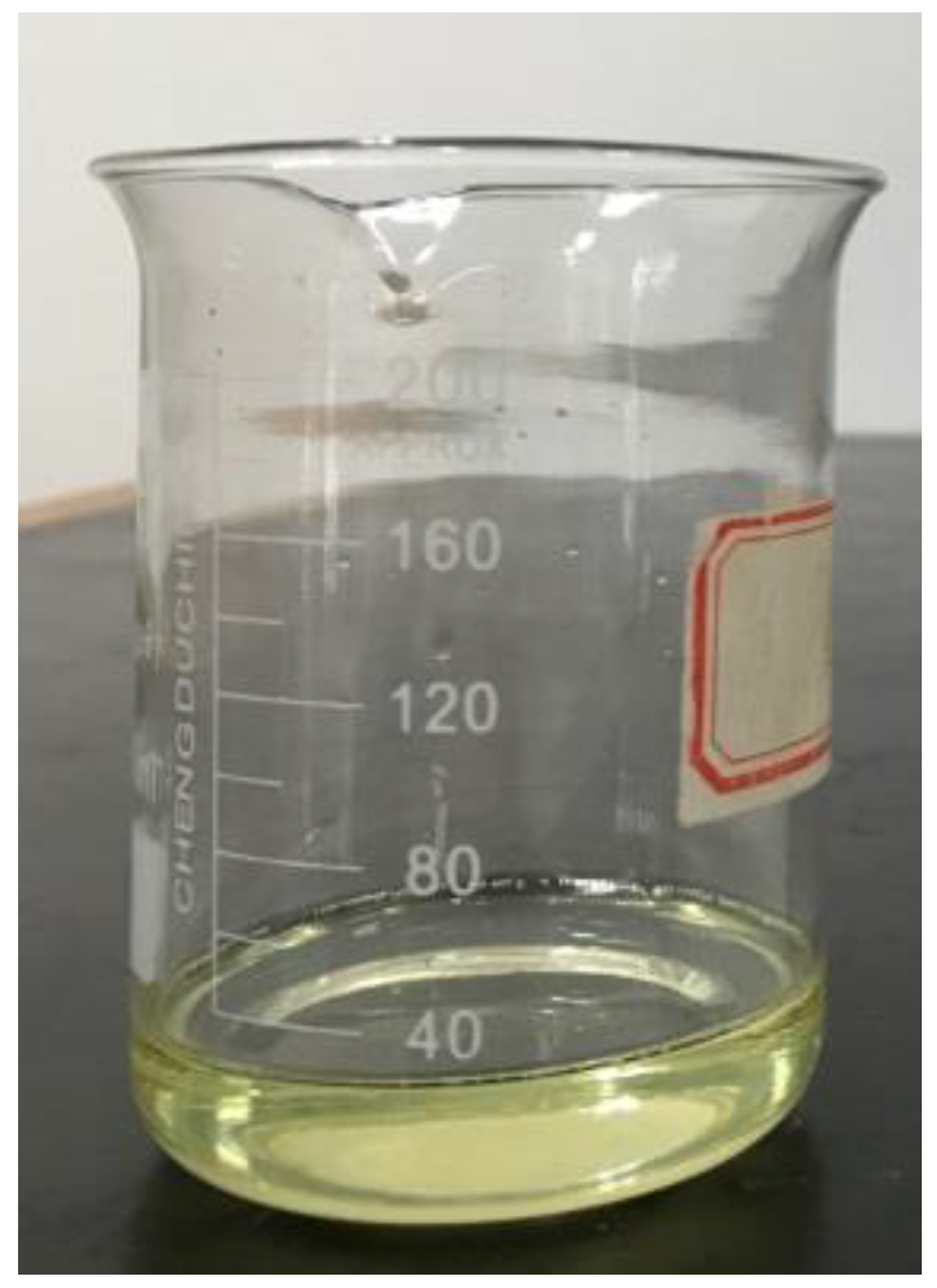


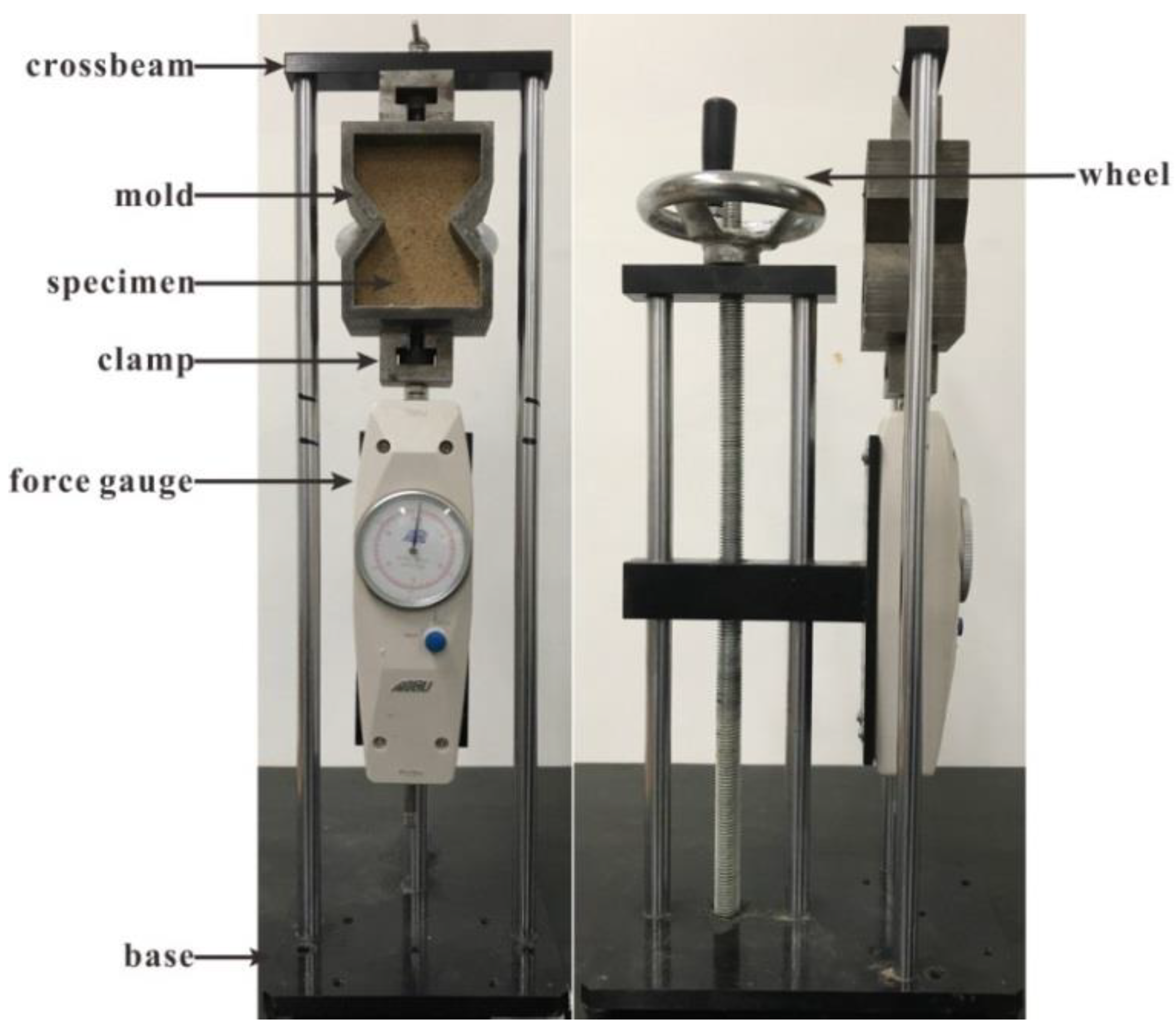
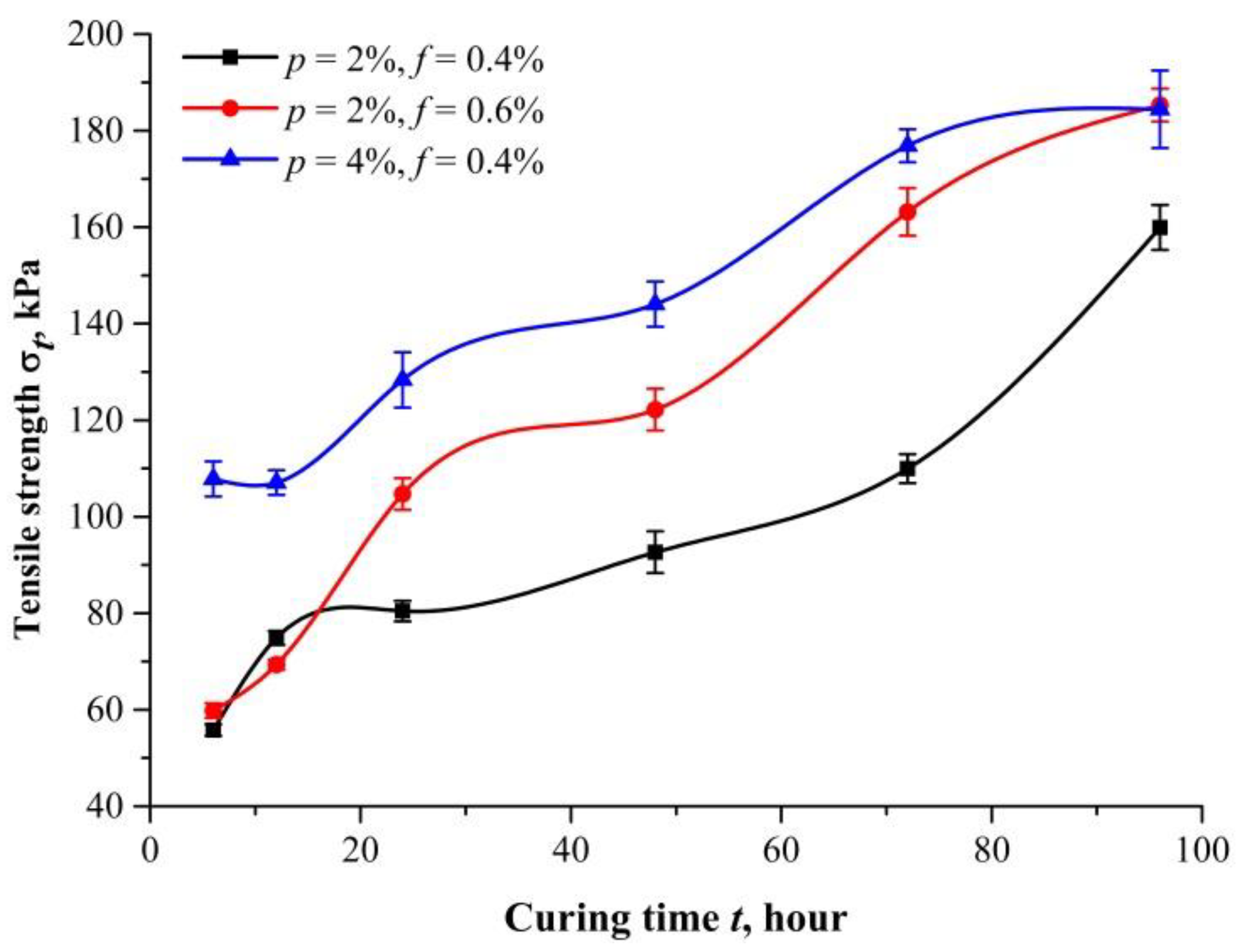




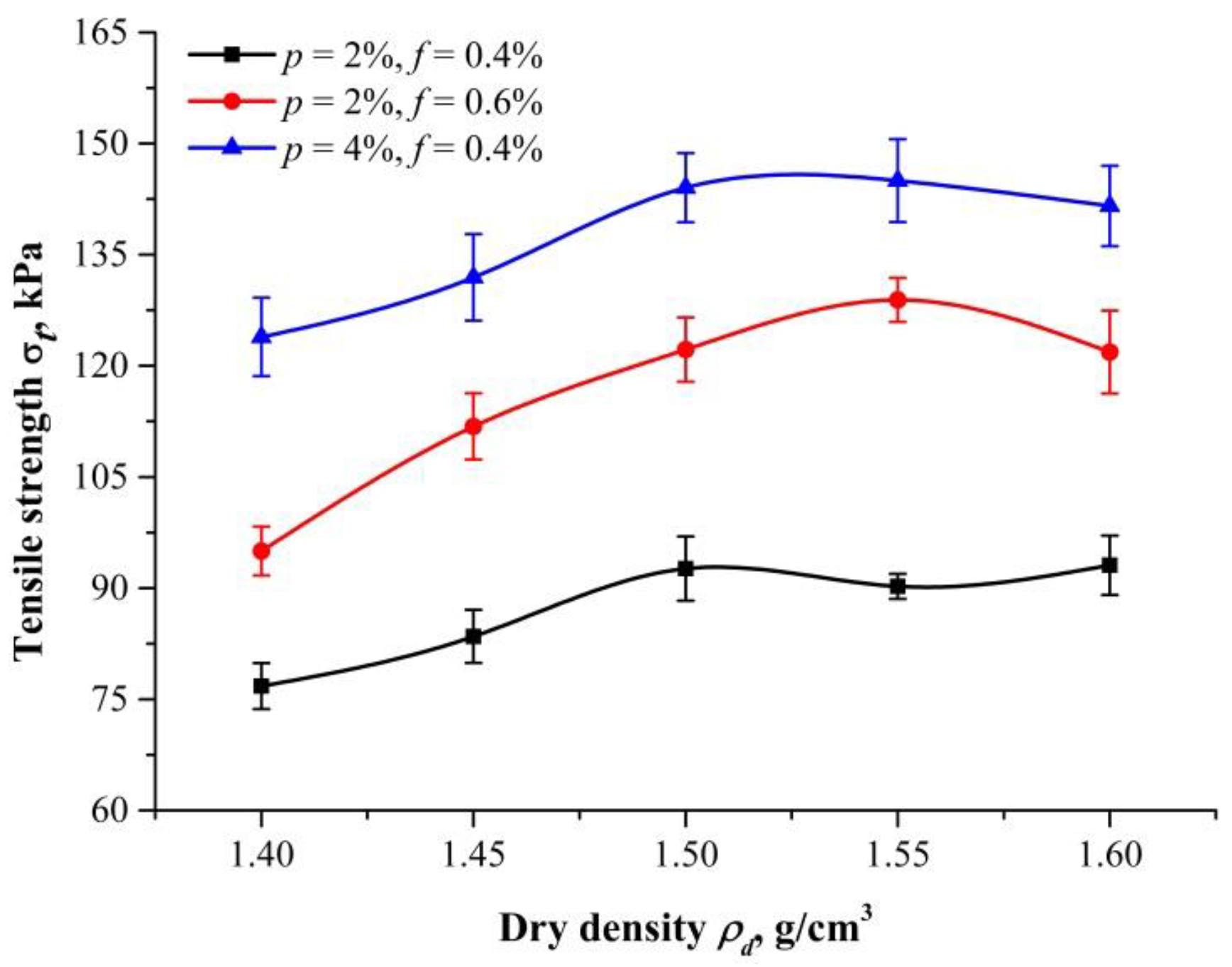
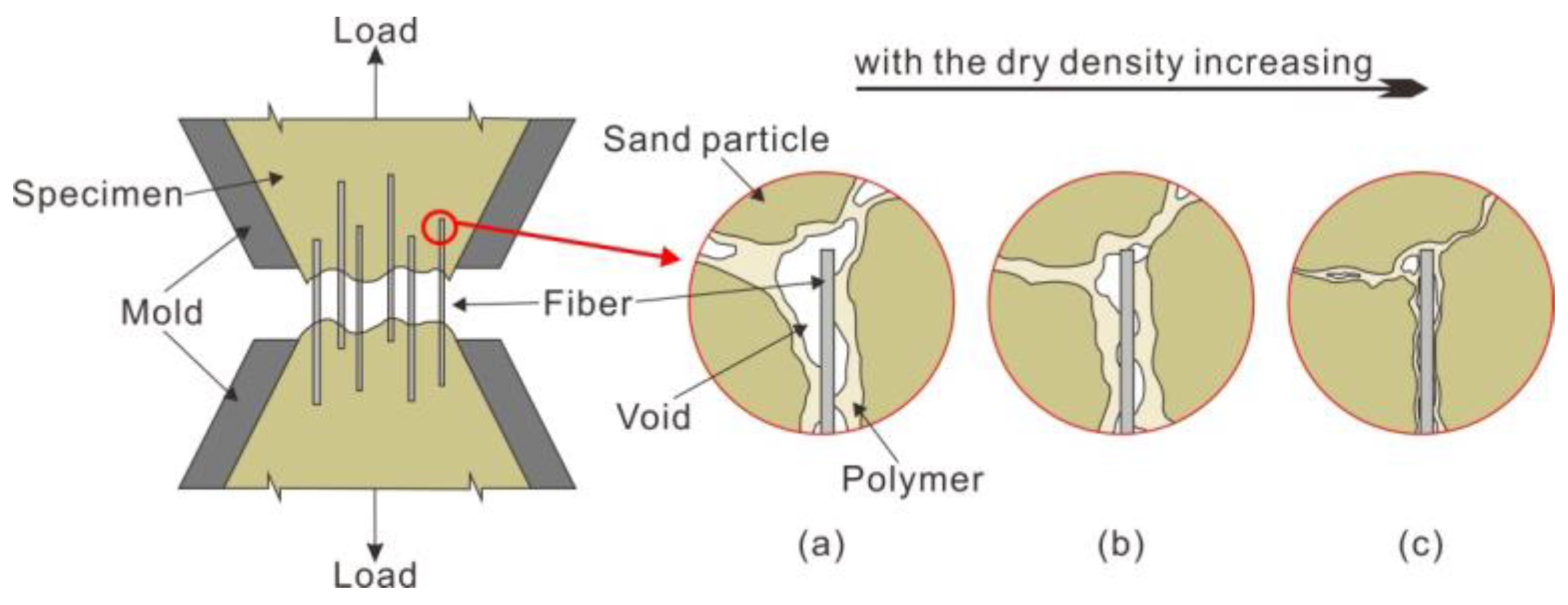
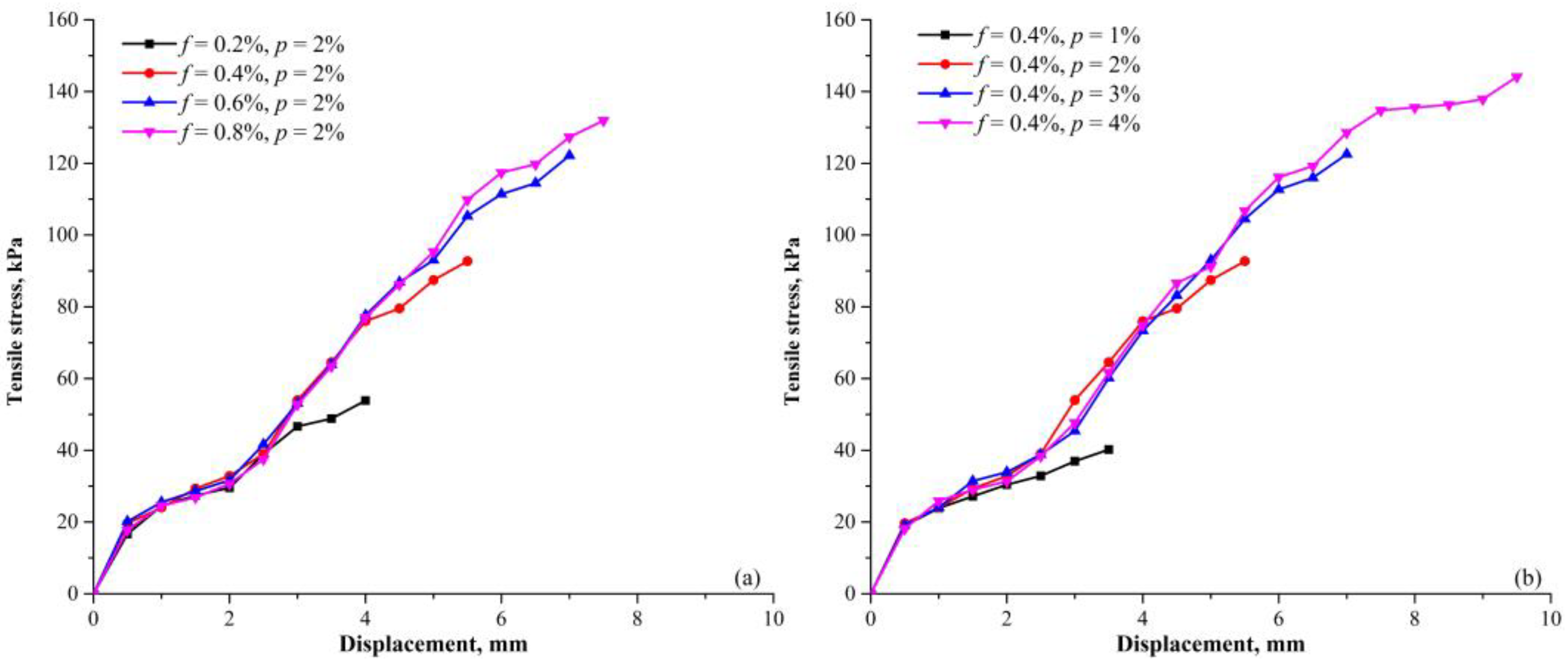

| Sand Properties | Value |
|---|---|
| Specific gravity (g/cm3) | 2.65 |
| Natural water content (%) | 2 |
| Maximum dry density (g/cm3) | 1.66 |
| Minimum dry density (g/cm3) | 1.34 |
| Maximum void ratio | 0.970 |
| Minimum void ratio | 0.590 |
| PF Properties | Value |
|---|---|
| Density (g/cm3) | 0.91 |
| Average diameter (mm) | 0.034 |
| Average length (mm) | 18 |
| Breaking tensile strength (MPa) | 300 |
| Modulus of elasticity (MPa) | 3500 |
| PU Properties | Value |
|---|---|
| Specific gravity (g/cm3) | 1.18 |
| Viscosity (MPa·s) | 650~700 |
| Appearance | Light-yellow transparent liquid |
| Mass fraction (%) | 85 |
| Solidification time (s) | 30~1800 |
| Water retention | Very good |
| pH | 7 |
| Test Number | PF Content f (%) | PU Content p (%) | Tensile Strength (kPa)/Standard Deviation (kPa) | ||
|---|---|---|---|---|---|
| 1.40 g/cm3 | 1.50 g/cm3 | 1.60 g/cm3 | |||
| A1-1 | 0.2 | 1 | 39.84/1.58 | 40.21/1.81 | 44.24/1.77 |
| A1-2 | 0.2 | 2 | 46.32/2.03 | 56.13/2.28 | 66.27/2.87 |
| A1-3 | 0.2 | 3 | 64.11/2.54 | 71.83/2.85 | 79.81/2.69 |
| A1-4 | 0.2 | 4 | 70.78/3.32 | 79.06/2.98 | 93.85/4.19 |
| A2-1 | 0.4 | 1 | 45.87/1.94 | 53.32/1.78 | 63.50/2.50 |
| A2-2 | 0.4 | 2 | 76.78/3.11 | 92.64/4.33 | 93.09/4.01 |
| A2-3 | 0.4 | 3 | 105.00/4.13 | 122.52/3.86 | 116.47/4.43 |
| A2-4 | 0.4 | 4 | 123.90/5.30 | 144.05/4.67 | 141.57/5.42 |
| A3-1 | 0.6 | 1 | 55.66/2.02 | 59.00/2.42 | 81.28/3.97 |
| A3-2 | 0.6 | 2 | 95.00/3.28 | 122.19/4.34 | 121.86/5.59 |
| A3-3 | 0.6 | 3 | 116.12/3.07 | 135.83/5.61 | 142.15/5.50 |
| A3-4 | 0.6 | 4 | 132.80/4.71 | 150.81/6.11 | 185.15/8.19 |
| A4-1 | 0.8 | 1 | 59.45/2.28 | 63.16/1.90 | 87.19/3.44 |
| A4-2 | 0.8 | 2 | 116.04/4.15 | 134.12/5.18 | 134.23/5.72 |
| A4-3 | 0.8 | 3 | 141.45/6.57 | 159.77/6.33 | 163.73/6.82 |
| A4-4 | 0.8 | 4 | 181.47/5.05 | 194.51/7.48 | 221.03/6.98 |
| Test Number | PF Content f (%) | PU Content p (%) | Tensile Strength (kPa)/Standard Deviation (kPa) | |
|---|---|---|---|---|
| 1.45 g/cm3 | 1.55 g/cm3 | |||
| B1 | 0.4 | 2 | 84.49/3.57 | 90.23/1.69 |
| B2 | 0.4 | 4 | 131.94/5.84 | 144.99/5.97 |
| B3 | 0.6 | 2 | 111.82/4.46 | 128.90/5.60 |
| Test Number | PF Content f (%) | PU Content p (%) | Tensile Strength (kPa)/Standard Deviation (kPa) | |||||
|---|---|---|---|---|---|---|---|---|
| C1 | 0.4 | 2 | 55.80/1.20 | 74.88/1.44 | 80.44/2.12 | 92.64/4.33 | 109.96/2.98 | 159.94/4.64 |
| C2 | 0.4 | 4 | 107.81/3.63 | 107.07/2.55 | 128.34/5.72 | 144.05/4.67 | 176.88/3.42 | 184.42/8.02 |
| C3 | 0.6 | 2 | 59.79/1.55 | 69.35/1.08 | 104.71/3.39 | 122.19/4.34 | 163.16/4.94 | 185.29/3.41 |
© 2018 by the authors. Licensee MDPI, Basel, Switzerland. This article is an open access article distributed under the terms and conditions of the Creative Commons Attribution (CC BY) license (http://creativecommons.org/licenses/by/4.0/).
Share and Cite
Liu, J.; Chen, Z.; Song, Z.; Bai, Y.; Qian, W.; Wei, J.; Kanungo, D.P. Tensile Behavior of Polyurethane Organic Polymer and Polypropylene Fiber-Reinforced Sand. Polymers 2018, 10, 499. https://doi.org/10.3390/polym10050499
Liu J, Chen Z, Song Z, Bai Y, Qian W, Wei J, Kanungo DP. Tensile Behavior of Polyurethane Organic Polymer and Polypropylene Fiber-Reinforced Sand. Polymers. 2018; 10(5):499. https://doi.org/10.3390/polym10050499
Chicago/Turabian StyleLiu, Jin, Zhihao Chen, Zezhuo Song, Yuxia Bai, Wei Qian, Jihong Wei, and Debi Prasanna Kanungo. 2018. "Tensile Behavior of Polyurethane Organic Polymer and Polypropylene Fiber-Reinforced Sand" Polymers 10, no. 5: 499. https://doi.org/10.3390/polym10050499






